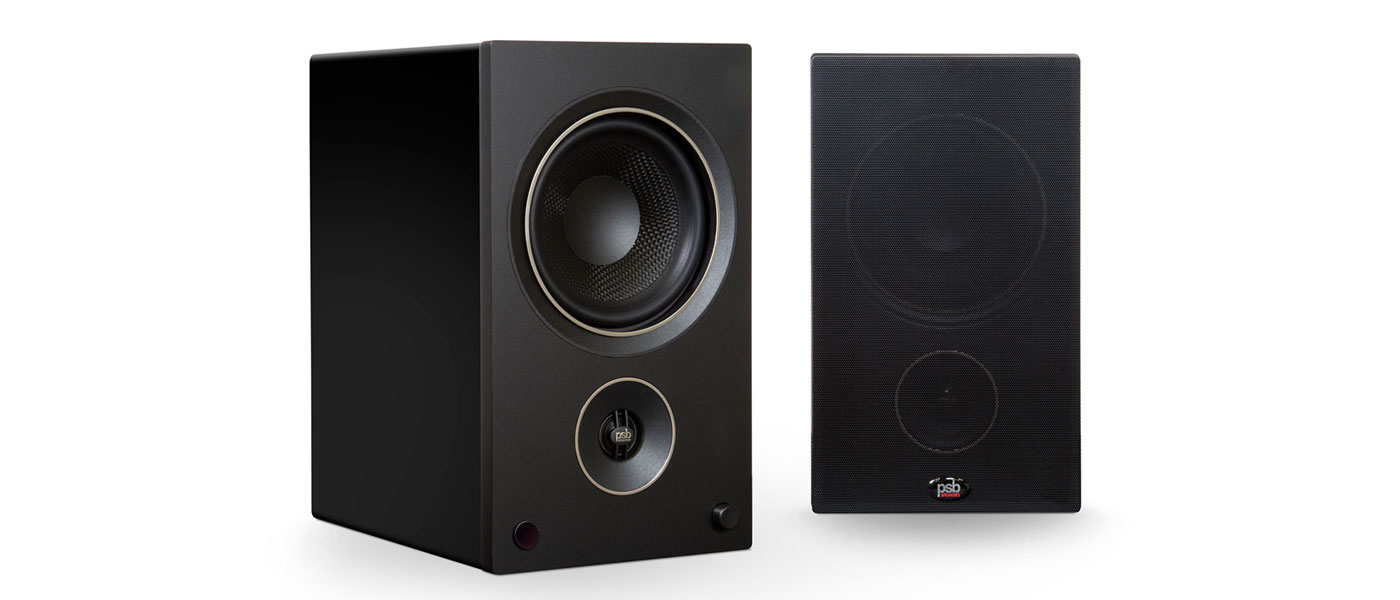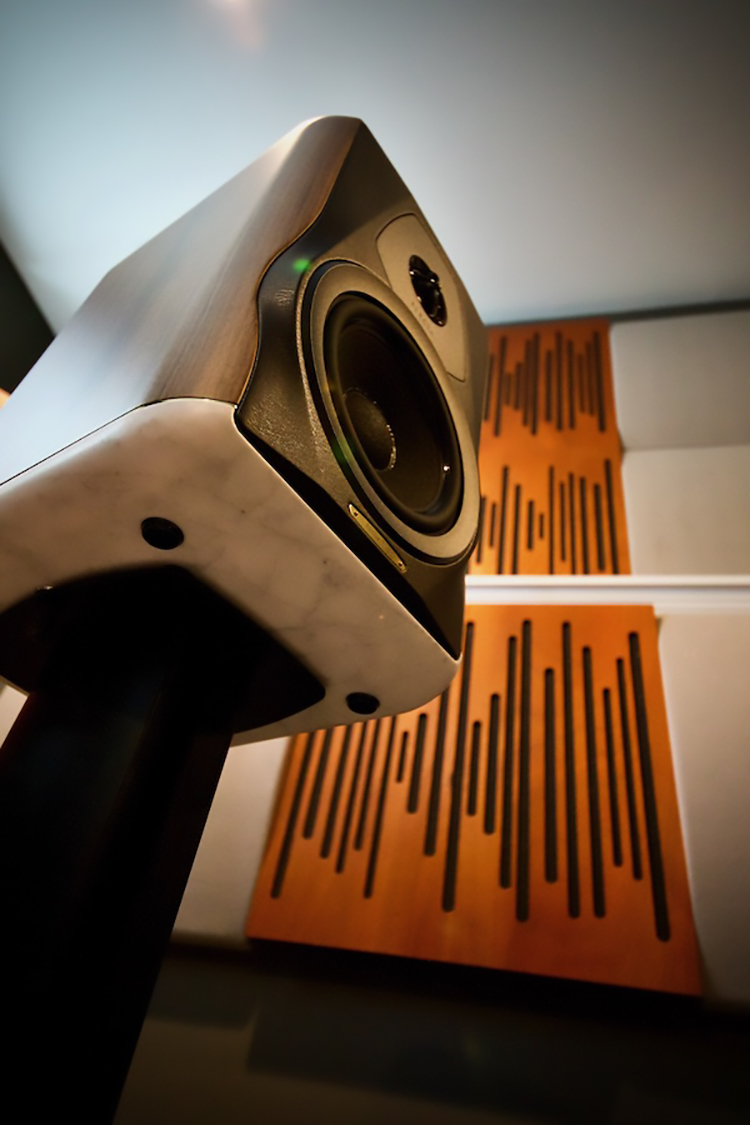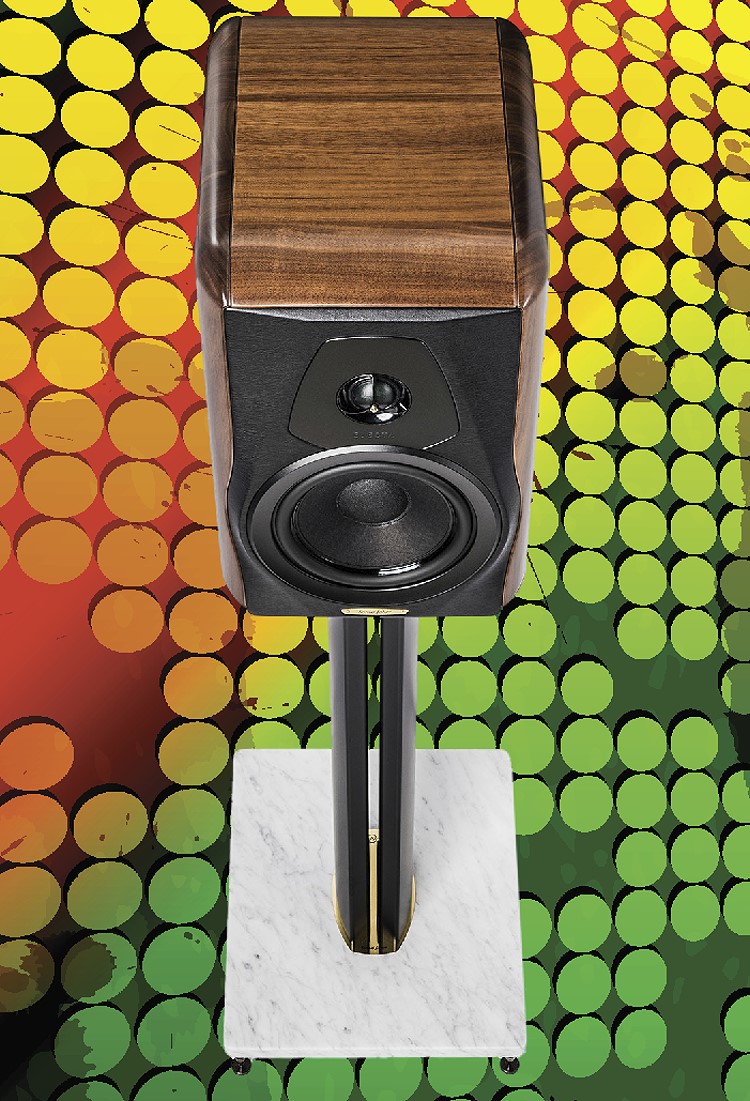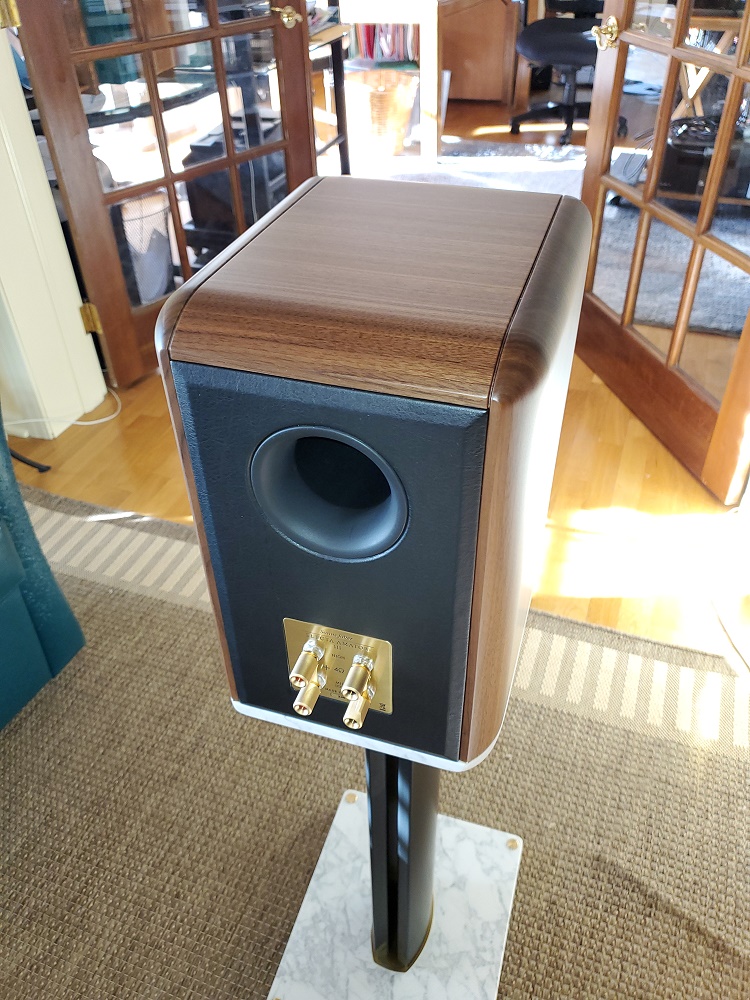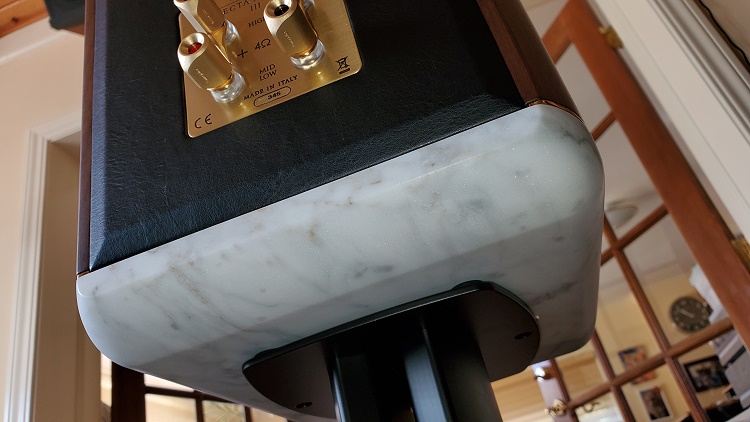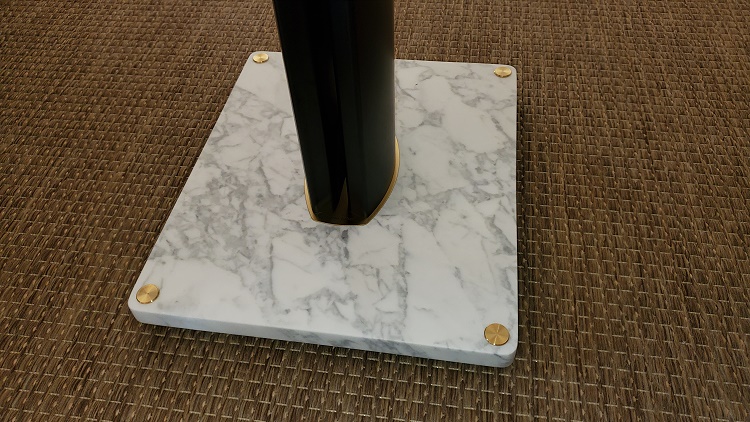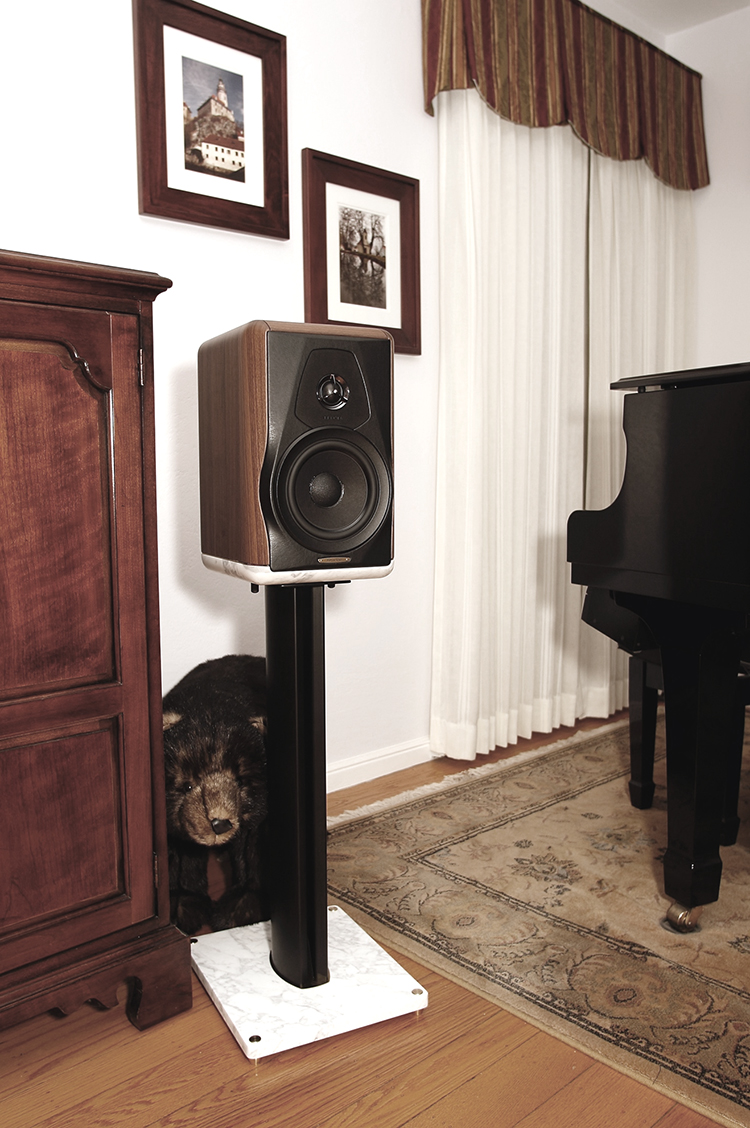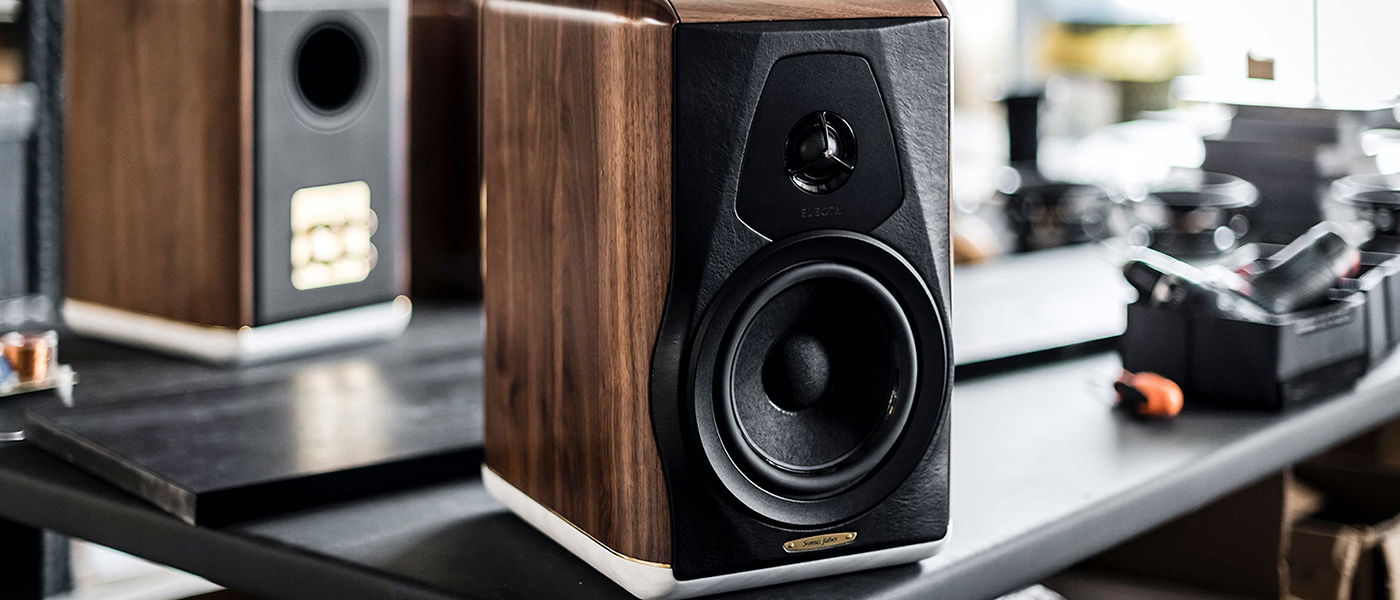
While this review initially began as a collaboration between Todd Cooperider and John E. Johnson Jr., it quickly ballooned as both found the Electa Amator III’s sound quality compelling enough to solicit additional impressions from JJ’s audiophile friends and neighbors.
Unless you are new to the audio world, you know about Sonus faber of Italy, and what they represent. Over the years you’ve seen their stunningly beautiful designs, which is typical for a premium Italian brand (think Ferrari). You’ve also read countless reviews, and know that they always have a high level of sound quality to back up the looks, and their premium prices.
Secrets Sponsor
Here we have their premium book-shelf / stand-mount speaker in the Electa Amator III, along with a pair of their matching stands. At $10,000 (with stands), it’s definitely at the high-end of small speakers.
Does the sound/build quality of the Electa Amator III speakers stay with the tradition of Sonus faber, and can they gain the appreciation and respect of a reviewer who normally prefers the full force of large, floor-standing speakers? Read on…
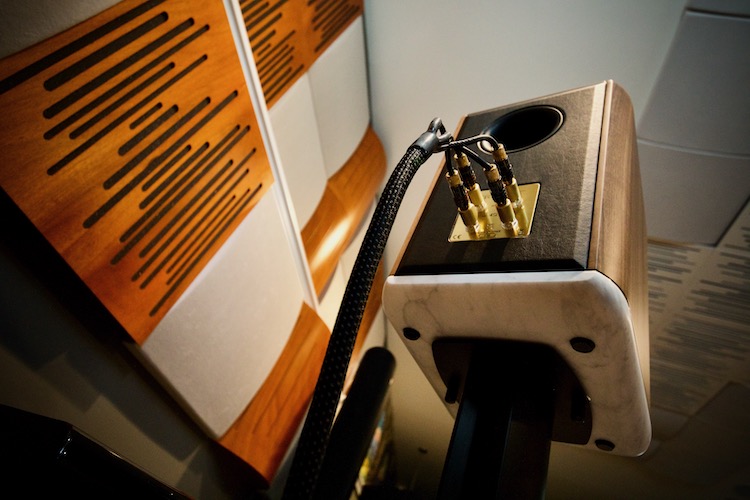
Sonus Faber Electa Amator III Speaker
- Italian design and craftsmanship
- Strong bass output for a small speaker
- Matching stands look as good as the speakers
- 2-way ported design
- Sweet highs
I must start this review by fully admitting that I am a sucker for fine design and craftsmanship. While some may argue that form follows function, I am one to stand up to that belief by saying that they are both equally as important, at least in my personal world. And given the success of luxury brands such as Ferrari, Rolex, or in this case Sonus faber, I am not alone in that bias or preference.
In 2018, Sonus faber was celebrating its 35th anniversary of producing some of the most visually appealing, and musical sounding loudspeakers in the market. And with that, they developed the Electa Amator III speakers to pay homage to both their company history, and the original Electa Amator (1987) and the Electa Amator II (1997). These two speakers contributed most to their international success and heritage brand.
So when the opportunity came up to review such an important speaker model from a manufacturer that has a long history of creating works of art both from a visual and auditory perspective, I was anxious to receive them.

Design:
2-way bookshelf / stand-mount vented loudspeaker system
Tweeter:
1.1″ Damped Apex Dome (DAD) silk tweeter
Midrange Driver:
6.5” cellulose pulp cone
Crossover:
2.5 kHz
Frequency Response:
40 Hz – 35 kHz
Sensitivity:
88 dB SPL (2.83V/1 m)
Nominal Impedance:
4 ohm
Suggested Amplifier Power Output:
35 – 100w, without clipping
Speaker Dimensions (HxWxD):
14.8” x 9.3” x 14.2”
Weight:
32.2 lbs/ea
Stand Dimensions:
28.4” x 11.8” x 13.8”
Stand Weight:
24.7 lbs/ea.
Price:
$10,000 per pair including stands ($8,500 without stands)
Website:
Company Directory:
SECRETS Tags:
Sonus faber, Electa Amator III, bookshelf speaker review, review 2020
When the Sonus faber Electa Amator III speakers arrived at my house on a pallet, I knew that they were very careful and serious about the packaging and shipment of their products. I had assumed that a 32 lb speaker would arrive via UPS, but their packaging was phenomenal, and they weren’t taking any chances on potential shipping damage for a $10,000 pair of speakers.
But when they arrived, I found out that the stands didn’t get shipped at the same time, so I would have to make do without them until they did as I don’t own a pair of stands. I wasn’t too worried about the delay because I wanted to give them plenty of break-in time before I really got down to critical listening, so proper placement to start wasn’t a big concern. Not having stands, however, afforded me the opportunity to learn something very interesting about the Electa Amator III that I will get into later in this article.
First, let’s talk a bit about the speaker itself, and how much of a work of art it is. Once removed from its protective packaging, you can’t help but to simply stare at them and marvel at the design, quality, and craftsmanship that Livio Cucuzza (Chief Designer at the McIntosh Group, and former Chief of Industrial Design at Sonus faber) and his team put into these speakers. Made from solid walnut that is sourced locally from the Sonus faber factory in Arcugnano, Italy, the Electa Amator III also incorporates a marble base with a thin strip of brass separating the two. Both the rear of the speaker and the front baffles are covered in locally sourced leather, which may sound like a bit of an odd combination, but the colors and textures combine to create one of the most visually appealing speakers that you may ever experience.
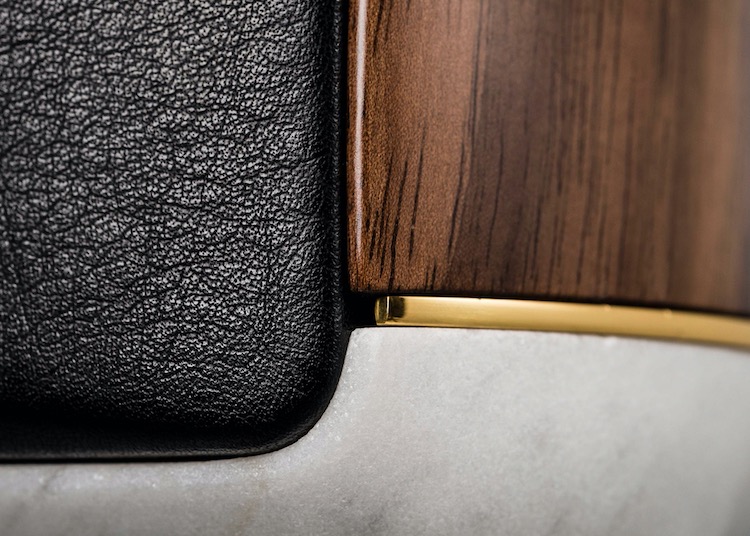
As for the stands that were designed specifically for the Electa Amator III’s, they follow the same design principles and materials as the speakers themselves. Featuring a marble base with black columns (filled with resonance-reducing material) that are accented by more use of brass and brushed aluminum, they look like a perfect extension of the speakers as opposed to the normal, bland looks of most stands. The spiked feet are great for carpeting, and they also include floor savers for those who have hardwood floors. The top plate of the stands has two mounting holes that allow the speakers to be securely attached to the stands using included bolts.
For source equipment during the review period, I powered the Electa Amator III speakers with a pair of McIntosh MC611 monoblock amplifiers, which was fitting since both companies belong to the McIntosh Group. At 600 watts each, the MC611’s are considerably more powerful than the recommended minimum range offered up by Sonus faber, but I found them to be a perfect fit. Additional gear consisted of a PS Audio BHK preamplifier, PS Audio DirectStream DAC, and PS Audio DirectSteam Memory Player. Cabling mostly consisted of Tributaries Series 8.
As I alluded to earlier, my initial shipment didn’t include the stands, so I had to improvise during the break-in period. My seating position is about nine feet from where I normally place my speakers, and the room width is about fourteen feet. My two SVS SB-16 Ultra Subwoofers normally rest towards the walls on the very outer edge of the room, just outside of where my speakers typically go. Having nowhere else to put the Electa Amator III speakers, I installed the included rubber feet (for bookshelf placement), and set them on top of the subwoofers. At about 12’-13’ apart, and towards the very edges of the room, and resting on a base that was only 20” tall, I knew that they wouldn’t sound their best.
Being the impatient person that I am (you should try driving with me when I’m behind somebody going below the speed limit!!), I went ahead and fired up the system anyway so I could give them a listen. Being spaced out that far, I was certain that the center image would not be very impressive because they were simply too far apart.
But when I played Any Place by the Bahamas through TIDAL (FLAC 96kHz 24bit), I was floored by what I heard. Not only did his deep voice come through with the authority in the lower regions that I am accustomed to, but the center image was perfectly placed. I played a handful of other songs that really emphasize a pinpoint and solid center stage, only to find the same results. Fortunately, these are not speakers that require demanding placement to get them to sound good!
Once the stands finally arrived, I was able to play around a bit with placement to see what would net me the best results. I knew that based on my initial findings that I wouldn’t have too much difficulty, but I still moved them around a bit just to see how different they may sound. Eventually, I ended up with a traditional placement of about 9’ apart, 9’ from my listening position, and toed-in directly towards me. With this, they ended up being about 2’ from the sidewalls, and about 4’ from the rear.
Before we get into too much detail about the listening experience, let’s talk a bit about the concept of bookshelf/stand-mount speakers, and what type of person may be interested in them. As with most audio reviewers, I do this on a part-time basis. The business that I own is automotive-related, and we get to work with a wide range of vehicles. Why are there so many different types of cars? Because there are so many different types of drivers and enthusiasts with an even wider range of budgets. The higher up the ladder you get, the more money you have to spend, and the more focused the benefits get. As a result, the potential market inevitably gets smaller as well. Speakers aren’t much different when you really think about it. You have a wide range of prices, sizes, shapes, and sound profiles. What may be “perfect” for one person would be right out of the question for another. It doesn’t make one right and one wrong. Some may look at a $10,000 set of small-ish bookshelf speakers and think it’s outrageous because they can buy a floor-standing speaker for less that has far more (bass) output. But not everybody is in the market for sheer output, and measurement specs are mere data points. What YOU as an audio enthusiast/consumer want and like is what’s most important, and reading reviews like this help you to decide if a product fits into your listening preferences and budget.
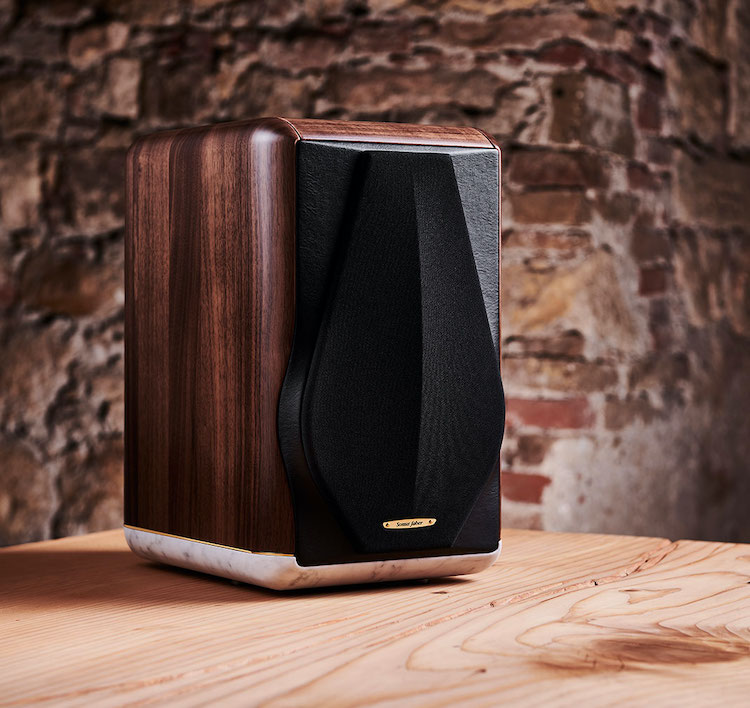
One of the big factors of bookshelf speakers versus floor-standing speakers is space. Typically speaking, if you have a very small space, you simply don’t have the ability to place a large set of speakers. Additionally, the large speakers may overwhelm the room. Likewise, if you have a big space, the smaller speakers may not energize the room enough to get a true sense of realism out of them. And yet another aspect is what kind of music you like to listen to, and how you prefer to listen to it. If you’re into full-scale dynamics at high volumes with a wall-sized soundstage, then big floor-standing speakers with a lot of drivers may be a better fit. But if you like more modest output, with three-dimensional soundstage and pinpoint imaging, then the bookshelf speakers/monitors would be a more natural fit.
With many bookshelf speakers, particularly at the higher end of the price spectrum, the design goal from the manufacturer is to provide a very neutral or analytical playback. Once again, this is a characteristic or playback preference that many people are looking for. But with the Sonus faber Electa Amator III, this is not what they were after when they set out to design them. During the voicing process, the designers’ goals were to add a little bit extra to both the top end and the bottom to create a more exciting listening experience as opposed to an analytical one. For my listening preferences, this type of design fits in perfectly with what, and how I like to listen to music.
Going back to our car references, I can compare this to a Porsche 911 vs. a Corvette driving experience. I owned a Porsche 991.2 Turbo S, which is one of the quickest cars made that is capable of runs from 0-60 mph in a mere 2.5 seconds. But the Porsche was so engineered and linear, that in daily driving it could get, well, boring! I also owned a C7 ZR1 Corvette with a 755 hp engine and a 0-60 mph time of only 2.9 seconds. In terms of being a pure sports car, the Porsche was the better and more refined of the two. But in terms of spicy fun-factor, the Corvette easily won as you always had the feeling that you were about to die! As with speaker types, these cars are designed for a specific type of driver with specific tastes and neither could be considered “wrong”.
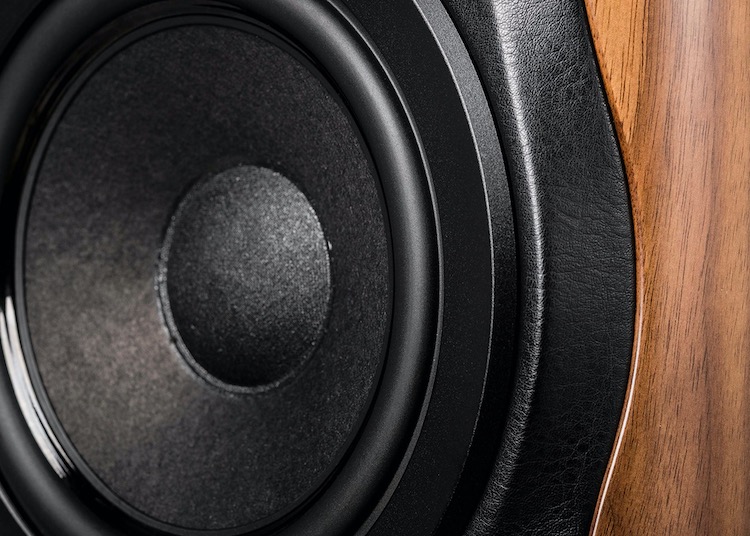
OK, now that we’ve talked a bit about the setup and all, let’s get into some listening observations! As I went through my notes, there was one trait in the Electa Amator III speakers that kept coming up, and that was with the tweeter. On many occasions, I wrote down that these speakers had some of the best sounding highs that I have ever experienced in my listening space. And as I dug a little deeper, it all came into perspective. The tweeter that is used on the Electa Amator II is the exact same model as used on their $130,000 Aida speaker from their Reference lineup. When I saw that, I simply thought, “Got it!”.
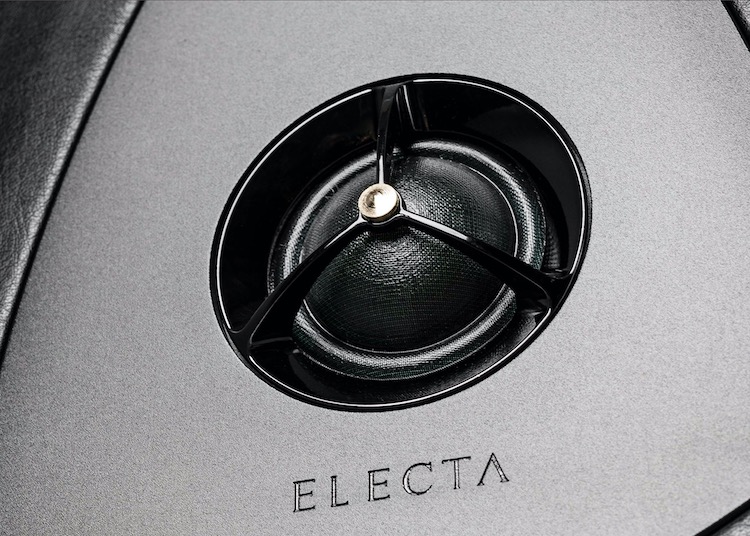
The highs were delivered with an ever so slight sweetness to them but came through with astounding realism without ever showing any hints of harshness or grain. I could listen at high levels for hours without a bit of strain or fatigue.
Another area that stood out was the low-end capabilities of such a small speaker. Now I’m not going to say that I could get the full playback from something like Kraftwerk’s The Man Machine (live), because that track has the kind of bass that can break windows. But in Patricia Barber’s Yesterdays from Nightclub (Mobile Fidelity SACD), Adam Nussbaum’s drums came through with stunning realism and impact, and at no time did I feel like it was missing anything. Additionally, on Kashmir by Vanessa Fernandes from her When The Levee Breaks album (Groove Note SACD), the bass output was smile-inducing, to say the least. This is an album that likes volume. A LOT of volume! While watching the bouncing needles on my McIntosh MC611 mono amps, I regularly saw the level at about 350 watts going into the Electa Amator III’s without a hint of strain or compression. If anything, they were asking for more. You might not think of a stand-mount speaker as one to produce very high volume levels, but the Sonus faber’s were more than capable while maintaining complete composure when pushed.
Not only did the Sonus faber Electa Amator III have the ability to impress at the far ends of the audio spectrum, but they also did in the mids as well with female voices. One of my new favorite tracks is Simple Twist of Fate by Sarah Jarosz, and playback through the Electa Amator III’s was such that I think I listened to it during every single session while they were in my possession. The decay from her voice hung in the air much longer than what I have experienced elsewhere, and it clearly placed me in the center of the recording studio. If you haven’t heard this track yet, be sure to check it out on TIDAL or Qobuz.
And while spatial imaging didn’t quite have the three-dimensional prowess as did the Super Nines from DeVore Fidelity that I previously had in for review, it didn’t disappoint, either. There were still plenty of instances where the speakers themselves disappeared into the room, and projected instruments front to rear, and side to side.
Todd Cooperider has written the primary review of these wonderful speakers, and I am providing the bench tests. But I cannot resist mentioning my own opinions. And, two neighbors who had the speakers for several days each are also chiming in.
Below is a view of the Electa Amator III on its matching stand. The beautiful finish includes twelve coats of hand-polished urethane over the solid walnut enclosure. The final appearance is a semi-gloss. Surrounding each of the two drivers is a layer of leather. You would not see most of this leather under normal circumstances because it is covered by the grille.
A dual-set of binding posts, which will allow bi-amping, is brass-plated.
The base of the speaker consists of a thick marble slab which helps to reduce resonance but is also just plain gorgeous. It is matched by the marble base on the stand. A number of different spikes are supplied for you to choose from. You can also bolt the speakers to the stands.
Even the crossover network is an artistic dream. Very, very high-quality parts.

I listened to the Sonus faber Electa Amator III Speakers with a computer (PC) delivering Tidal music streaming via USB input to an OPPO UDP-205 Universal Player, a hard drive connected to the UDP-205 with my entire digital music collection stored on it, VPI-HR-X Turntable with Sumiko Palo Santos MC Phono Cartridge, Manley Labs Steelhead Phono Preamplifier, Pass Labs Xs Preamplifier, Pass Labs Xs 300 Power Amplifiers, Wireworld XLR cables, and Clarus Crimson speaker cables. I used a Clarus Concerto Power Conditioner for the computer, OPPO UDP-205, Manley Labs Steelhead Phono Preamplifier, and Pass Labs Xs Preamplifier. There is no power conditioner out there that will handle the two Pure Class A 300 watt Pass Labs Power Amplifiers, especially when the computer, universal player and preamplifier are also plugged into it. In particular, the Xs 300s are wired for 240 volts because they are huge-demand amplifiers weighing 300 pounds each. I placed the two Electa Amator III Speakers about 10 feet apart, angled inward at about 15 degrees. I listened at about 12-15 feet from the speakers.
Complete List of Reference Components: OPPO BDP-105 Universal Player (4), OPPO UDP-205 Universal Player (2), VPI-HR-X Turntable with Sumiko Blackbird MC Cartridge and Sumiko Palo Santos MC Cartridge, Manley Labs Steelhead Tube Phono Preamplifier (2), Balanced Audio Technology VK-5i Pure Class A Triode (Tube) Stereo Preamplifier (2) (Fully Balanced), Balanced Audio Technology VK-500 Solid State Stereo Power Amplifier (Fully Balanced) (250 Watts per Channel), Pass Labs Xs Preamplifier, Pass Labs Xs 300 Monoblock Pure Class A Power Amplifiers (2) (300 Watts/each), Parasound JC 1+ Monoblock Power Amplifiers (2), Lamm LL1 Signature Stereo Pure Class A Triode (Tube) Preamplifier, MartinLogan CLX Full-Range Electrostatic Speakers (2), Magnepan 20.7 Planar-Magnetic Speakers (2), Sonus faber Lilium Speakers (2), Paradigm Reference Signature SUB 2 Subwoofers (2), Custom-Built Computer for Audio Analysis, Accupel HDG-3000 Digital Color Signal Generator (1080i capable), Component Video and DVI Output, ColorFacts Pro Video Test and Calibration Software, Version 6.0, Spyder Sensor, SpectraPlus Audio Analysis Software, Audio Precision SYS-2722 Spectrum Analyzer, Staco 3PN2210B-DVM 22 Ampere Variable Transformer (for adjusting line voltage to 120 volts during amplifier power output tests), Pass Labs XP-20 Stereo Preamplifier, Classé SSP-800 Surround Sound Processor, Emotiva XMC-1 Surround Sound Processor, Classé CA-5200 Five-Channel Power Amplifier (200 Watts per Channel), Pass Labs X600.8 Power Amplifiers (4) (600 Watts/Each), Audio Control Phase Coupled Activator (Sub-Harmonic Generator), Carver Platinum Mark IV Ribbon Speakers (2), MartinLogan Summit X Hybrid Electrostatic Speakers (2) (Rear Left/Right), MartinLogan Stage X Hybrid Electrostatic Speakers (3) (Center and Sides Left/Right), Velodyne DD-18+ Subwoofer (3), HiFiMAN HE1000 Planar Magnetic Headphones, OPPO PM-1 Planar Magnetic Headphones, OPPO HA-1 Headphone Amplifier, Bryston BUC-1 USB Converter, Sony VPL-HW55ES 1,920 x 1,080p Digital Projector, 90″ (Diagonal) Stewart Grayhawk Projection Screen, Sony 75″ UHD (4K) Flat Panel Display, Clarus Audio and Wireworld cables, Clarus Concerto Power Conditioner with Crimson Power Cable.

Music – Art Pepper meets the Rhythm Section – Original Jazz Classics – Released 12/31/2009
This album is my go-to for instrumental realism. Art Pepper’s alto sax was recorded very close to the microphone here, and any straying from the clarity and detail would be obvious. Well, no straying with the Electa Amator III’s. He was right there next to me. The sax sound was very natural with just the right amount of buzz that is created with reed instruments due to saliva getting into the mouthpiece.

Music – Mozart’s Violin: The Complete Violin Concertos; Christoph Koncz – Sony Classical – Released 10/8/2020
Violins are a good instrument for tweeter tests. Low distortion gives a smooth, sweet sound. I enjoyed the Adagios in Concertos Nos. 1, 3, and 5 most because these days, I need the relaxation that adagios provide. I have not heard of this particular musician before and was delighted with the new experience.

Music – Domenico Scarlatti: Complete Keyboard Sonatas Vol. 25; Pascal Pascaleff, Piano – Naxos – Released 10/8/2020
The piano is another great instrument for listening tests because ten or more keys can be played at the same time, making the sound very complex. A weak speaker will sound mushy. No such problem for the Electa Amator III’s. Each note was distinguishable with great clarity.

Music – A Healing Fire: Bach, Britten, Gubaidulina, Hetu; Smaro Gregoriadou – Delos – Released 10/8/2020
This is a wonderful album with classical music for guitar and some compositions arranged for guitar (not the original instrument). I discover new albums like this constantly. Sometimes I wonder what music classical composers would have come up with had they had LSD available to them. Probably not nearly as blood-pressure-reducing as this music. The strings had just the right amount of “twang” to them. Good leading edges, but not overly so. Sonus faber speakers are marvelous for reality.


Music – Van Halen: 1984 – Rhino Warner Records – Released 1/3/1984
Photo of Eddie: https://www.sanderseureka.com/obituary/Edward-vanHalen
With the recent (October 6, 2020) loss of Eddie Van Halen to throat cancer, I was reminded of this officially platinum album released in the ’80s. I had the original vinyl and stupidly gave it away when digital music hit the shelves. Jump and Panama, what ******* music! The Electa Amator III’s handled this intensity with alacrity.

Music – Norah Jones: Come Away with Me – Blue Note – Released 12/31/2012
Norah Jones is one of our most enduring singers, and this album is a perfect example of why. She records very close to the microphone. Her voice sounds exactly the same as with the Sonus faber Lilium speakers that I reviewed some time ago. Just not as huge a soundstage because the Amator III’s are a smaller stand-mounted speaker. But . . . certainly close. I am truly amazed.
On a recent autumn weekend, I excitedly welcomed my first house guests since the global pandemic declaration. During the next 7 days, they would captivate me with their Italian divineness.
“I am more a music lover than an audiophile” – Paolo Tezzon
Paolo Tezzon, Sonus faber’s Brand Ambassador, knows what the heart desires. With an education in psychology, he helms masterful industrial and audio design teams- and heralds the artist.
My introduction to this generation of Sonus faber, and the loftiest realm of hi-fi, began during a salon featuring their Lilium speaker model. That sound system’s voice and realism were a spiritual awakening. In particular, I will draw soulful reflection from Roberta Flack and her band performing 1969’s “Compared to What”, seemingly congregated a few feet away to lay down the track for her debut album.
I had just experienced one of the planet’s purest and most beautiful forms of audio reproduction. As someone passionate about music, but from the audio equipment territory of mere mortals, I fumbled for words to describe the salon session to a close friend. When poetry is required my command of the English language is more will than skill.
*A pair of exquisite Sonus faber Lilium speakers retail for US $75,000. Enjoy Dr. John Johnson’s technical review of them here.
“Where words leave off, music begins” – H. Heine
The Lilium salon experience facilitated and informed a one-week test drive of the Electa Amator III. Lucky me.
Electa Amator III
Introduced by Sonus faber in 2018 the Electa Amator III is a 2-way bookshelf loudspeaker that breaks barriers. Give yourself permission to consider them an acquisition of art.
Immersive. Emotive. You are immediately aware of their realistic, if not holographic sound stage. Like the Lilium, the transparency of each instrument’s musician and vocalist peers out during play.
Using modern design language, the Electa Amator III and its accompanying stand combine wood, leather, metal, and Carrara marble materials. None of the pictures I’ve seen translates the visual aesthetic of sharing your living space with these speakers. They are earthy, precious gems.
Sonus faber’s product sheets suggest the Electa Amator IIIs easily plug into any environment. As it turned out I was a good use case, and within 10 minutes of delivery system setup was complete. During the test drive, the speakers were powered by a Marantz PM-8005 2-channel Integrated Amp and joined by an SVS SB-1000 Subwoofer.
My first listening session was an interactive marathon. Playing in a home lounge, the Electa Amator IIIs provided a sumptuous audio experience. Their sonic characteristics clearly share engineering DNA with the Lilium. Sonus faber’s sound design recipe: “reproduction that is natural… does not sound like an artifact” is achieved so handsomely.
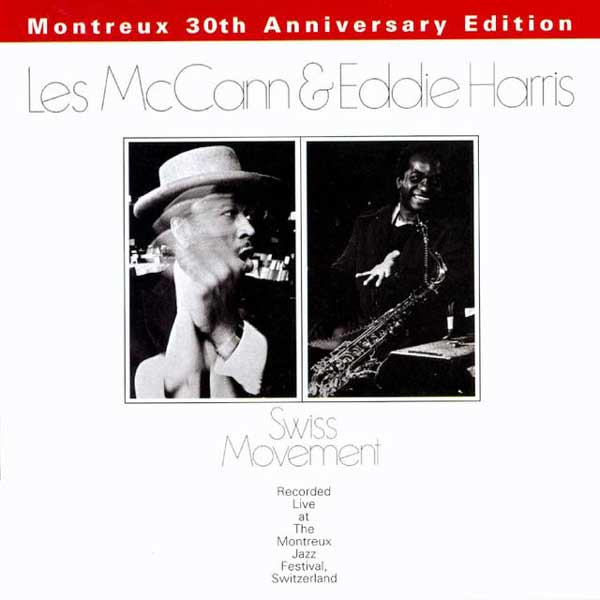
Les McCann & Eddie Harris – “Cold Duck Time”
This listen quenched some of my thirst for live musical performance. The Electa Amator III’s transparency and realism drawing me into the audience at the Montreux Jazz festival as they grew more electrified during the group’s set. The sound of tableware clinking in the smoke-filled venue, romp of saxophone and trumpet, crowd cheers, driving beat of the hi-hat. Each of Les McCann’s piano riffs and vocal improvisations, no longer masked in mid-range, are a sip of joy. “With your help, we might do it!”
Jazz history: It was during the 1969 Montreux Jazz festival that Les McCann & Eddie Harris’ band recorded what would become the opening track of their live album, Swiss Time. That song, “Compared to What”, helped propel the album to certified Gold sales. At the time, making this version better known than Roberta Flack’s.

Luigi Boccherini, Pablo Casalas, Orchestra Lamoureux & Maurice Gendron – “Cello Concerto in B-Flat: III. Rondo (Allegro)”
More Italian virtuosity provoking euphoria and a gush of dopamine. The Electa Amator IIIs were flawless and their star probably shines brightest within the classical repertoire. Tonal clarity leaving you wondering what other delicious musical feasts have been hidden in your world. I was asked do those speakers “change the temperature” in the room? They must, your heart glows.
The company’s literature illuminates a bit about how this audio reproduction feat is facilitated, as both the Lilium and Electa Amator III incorporate Sonus faber’s most key technologies. It’s pretty incredible, given the very different scale of these two speaker models.
Test Drive Component List
Marantz PM-8005 Integrated Amplifier, SVS SB-1000 Subwoofer, Marantz CD6006 CD Player, Sonos Connect, pair of Sonus faber Electa Amator III loudspeakers. (Kicked to the curb, my Quad 22Ls.)
In my case, floor space for large speakers became a premium years ago. Speakers got smaller and so did the sound. I went through a period with just a basic home theater system. Nothing to write home about. My most recent listening experience has been through home theater systems with an electrostatic speaker setup which put out a nice full balanced sound but requires a lot of real estate. I’ve been looking to bring a stereo system back in the house since I retired. Bookshelf speakers just do not provide the sound I am looking for. I want speakers that fill the space with beautiful music but that do not overwhelm the room.
I am a vintage kind of guy; I appreciate the warmth and character you get out of vintage amps. They are also a good match for my budget. I listen to music on vintage components in my workshop. When I was given the chance to listen to the Sonus faber Electa Amator IIIs, I jumped at the opportunity. To listen to these speakers, it was off to the workshop to dust off a Denon POA-2800 amplifier, PRA-1200 Preamplifier, and a Martin Logan Dynamo 700 subwoofer. My music files came from iTunes and CDs which did not give me the sound quality I expected. Somethings like CD players do not age well. Thanks to my good friends I was able to use an OPPO BDP-105 to bring music files through the onboard DAC using a USB hard drive.
I was excited when the Sonus faber Electa Amator III’s finally arrived, the speakers are beautiful. Truly a work of art. The small compact size and elegant design made it easy to have them front and center in the room. This system was clearly built with craftsmanship in mind. The speakers are made of rich walnut, smooth Carrara marble, and are finished with leather and brass accents. The speakers sit on stands made of matching Carrara marble. When you plug them in the sound pours out and swirls around the room bringing an immediate smile to your face. It is smooth and crisp with a clarity that might bring on an “eargasm”.
The speakers are a good fit for a medium-sized room with styling that will look good in any room. I played with placement to find my best sound; ended up about 24 inches from the wall and 8 feet apart. Remember floor space is at a premium. The Electa Amator III’s brought a private concert to my living room. I haven’t just sat around and listened to music for a long time; this past week my home has been filled with music. The Electa Amator III’s have a rich deep bass that will pleasantly surprise you. I even forgot to plug in the subwoofer a couple of times…couldn’t even tell it was missing. There is a clarity and sweetness to the high end that will keep you coming back for more.
The Sonus faber Electa Amator III sounds great with the Denon equipment. I could see building a system around these speakers. With every upgrade on the front end, the Electa Amator III will just sound better. Did I enjoy them? Oh yes.
I listened to a wide range of music, jazz, R&B, rock, country, classical, choral, and blues. Whatever your musical preference, these speakers will not disappoint. Here are a few of my favorites.

Andra Day, Cheers to the Fall, Rise Up
Andra Day has an incredible range to her voice and the quality really shines through with the Electa Amator IIIs. When she hits the high end of her register it will give you goosebumps. Grab the volume control and crank it up as you “Rise Up!”

James Ingram & Patti Austin, Greatest Hits: The Power of Great Music, How Do You Keep The Music Playing
This song has special meaning to me. It was my wedding song. My wife and I try to live by the motto of keeping our music alive. In duets as in life, there are often two voices that need to be heard and not muddle together. The Electa Amator III speakers do a beautiful job of balancing the voices so that you hear each voice individually…and together.

Sade, Stronger Than Pride, Haunt Me
Sade is one of my favorite female artists. In this piece, instrumentals twist and weave together with Sade’s voice in a haunting beauty. The first instrumental you feel your way along noticing each pluck of the string and strike of the keys and the moody trumpet in the second half carries you along. It’s as if you’re being lulled along the serene lazy path of Sade’s music.

Moonlight Sonata:1st Movement, Ludwig Van Beethoven, Peaceful Classics Volume 4
My wife suggested this beautiful piece. The Electa Amator III’s bring the piano to life. You are immediately drawn in by the resonance of the low end on this piece. The sense that you get when you strike a low-end key on a well-tuned piano. Midway through the tweeters shine with sweet clarity. The notes just flow over you. My wife added, “It will bring a tear to your eye”. Did I say I love these speakers!
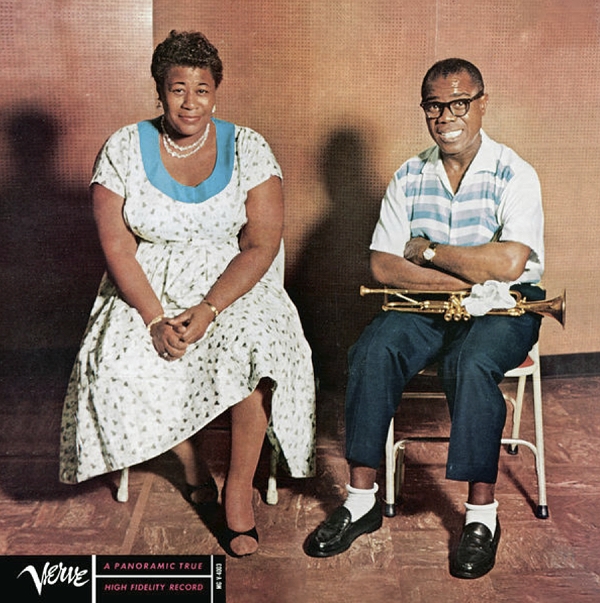
Louis Armstrong and Ella Fitzgerald, Isn’t This a Lovely Day, Ella Fitzgerald and Louis Armstrong Jazz Masters 24
This song I like for the playfulness between Ella Fitzgerald and Louis Armstrong. You can hear every supporting instrument in the background. Turn the lights down, volume up, and close your eyes. You’ll find yourself at an intimate jazz club in New Orleans. Cognac anyone?
Bench tests and technical analysis by John E. Johnson Jr.
Measurements were taken at a 1-meter distance on-axis in between the tweeter and woofer. The speaker was on its stand and the grille was on.
Here is the Impulse Response (IR).
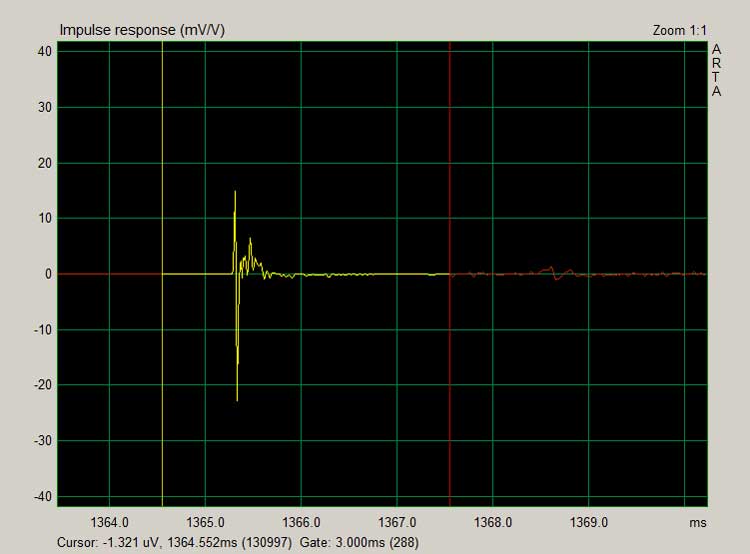
I windowed the IR (left yellow vertical line and right red vertical line in the spectrum shown above) for the Frequency Response (FR) and Distortion spectrum, shown below. The FR is reasonably flat (an IR-derived frequency response eliminates most of the effects of the room) and extends out to 30 kHz (perhaps beyond that, but my laboratory-grade microphone is calibrated to 30 kHz). Distortion stays below 1% for most of the frequency range. It rises below 60 Hz because the response falls off below 60 Hz. The yellow line is the FR, the blue line shows the 2nd-ordered harmonic for various frequencies, the gray line is the 3rd-ordered harmonic, and the pink line is the 4th-ordered harmonic. Notice that the 2nd-ordered harmonic (blue line) is the predominant one throughout almost the entire spectrum. This is marvelous because the 2nd-ordered harmonic makes the sound very appealing. It is not a typical spectrum for a speaker, and it is one of the things that you are paying for here.
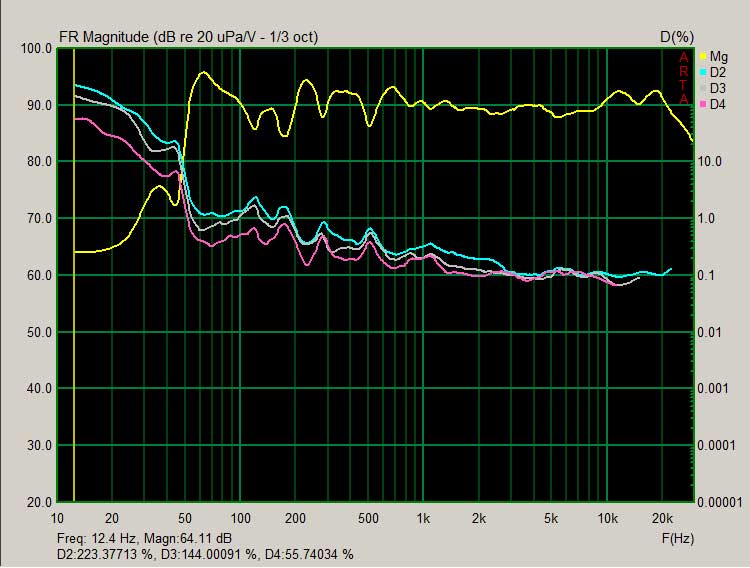
The room frequency response (response with room effects) on-axis is shown below. It is similar to the IR-derived frequency response with slight differences. White noise is used to derive the room FR.
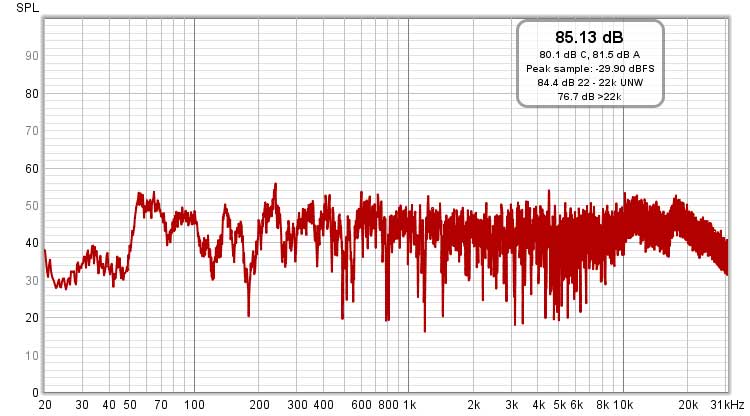
At 45° off-axis, the room FR drops off above 6 kHz. This is expected.

Using a 1 kHz sine wave at 80 dB SPL, the 2nd-order harmonic at 2 kHz is 0.84% distortion. The remaining harmonics represent smaller distortion components.
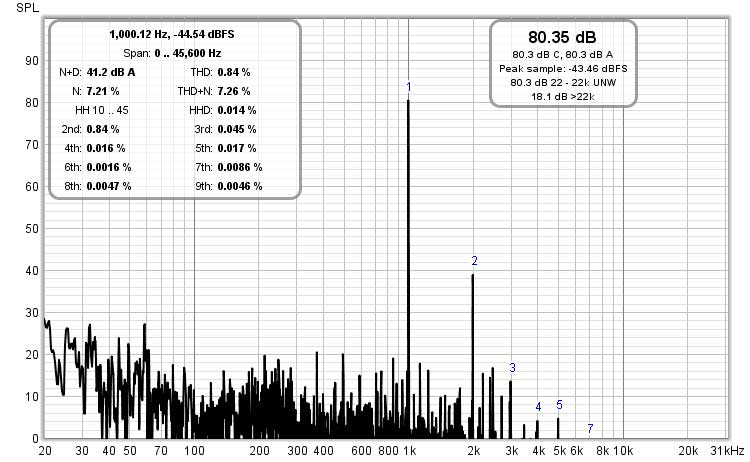
The step response is shown below. Both drivers are in-phase (they both move out of the enclosure together). The tweeter begins at 1,365.35 ms (milliseconds) and the woofer at 1,365.5 ms, so there is 0.15 ms in between. The peak at 1,368.65 ms is the port.
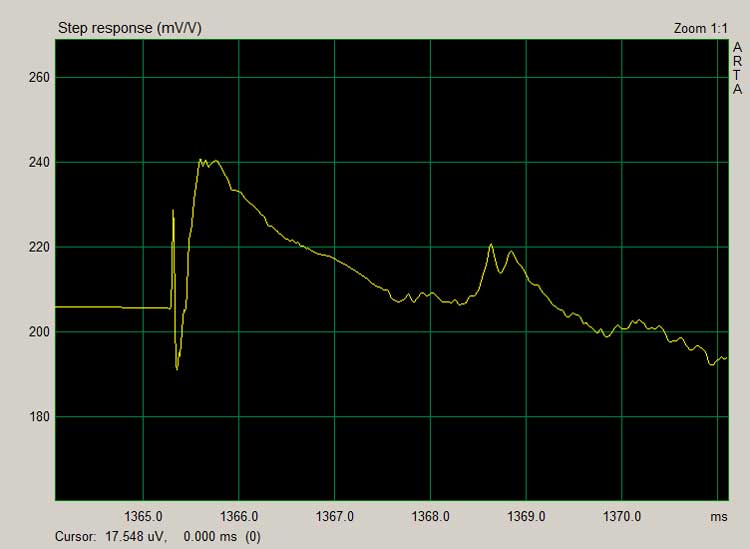
The Cumulative Spectral Decay (CSD below) has well-controlled enclosure resonance, partially due to the heavy marble base, with some driver resonance at higher frequencies (5 kHz – 18 kHz). All in all, a very good display. It’s over at 2 ms, having begun at 0.5 ms, so the resonance decay is 1.5 ms in length. Excellent.
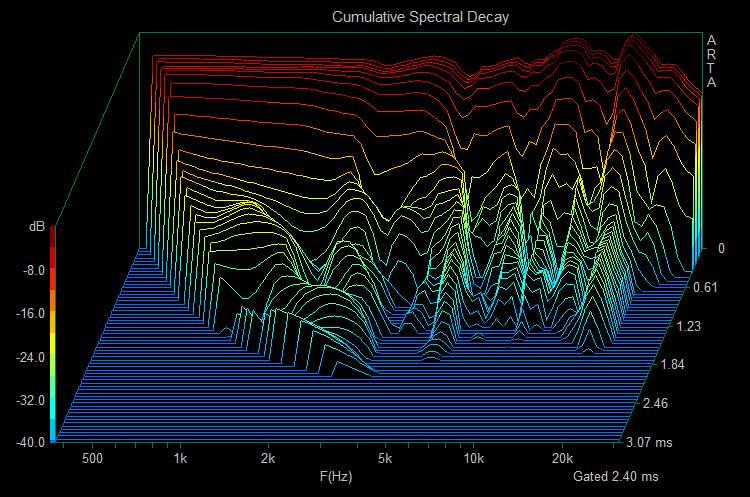
An Impedance/Phase plot shows that the Electa Amator III’s are 4 ohms generally (red plot) with peaks at 31 Hz, 80 Hz, and 2.3 kHz. Phase (green plot) varies from a maximum of +480 at 27 Hz to a minimum of -620 at 90 Hz.
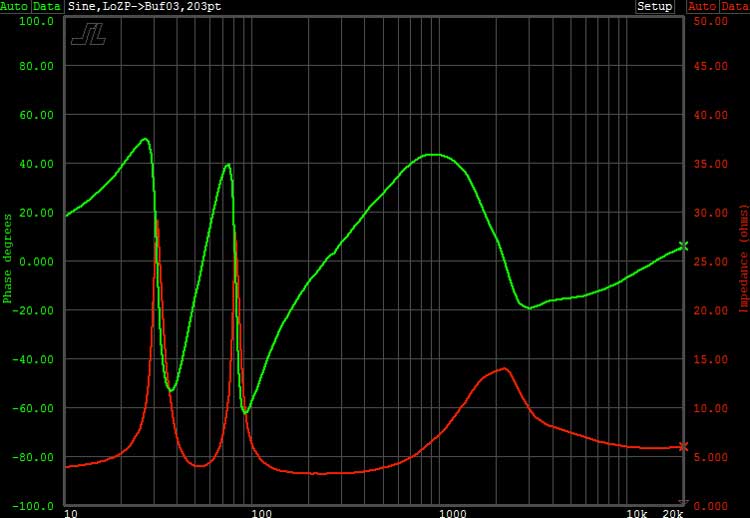
On the oscilloscope, 60 Hz. A very nice waveform at the low end of the spectrum.

At 1 kHz, perfect symmetry.
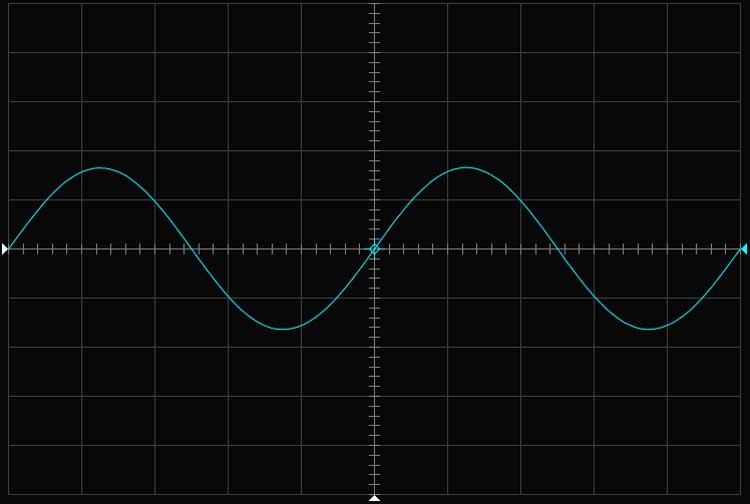
10 kHz (below). Again, excellent.
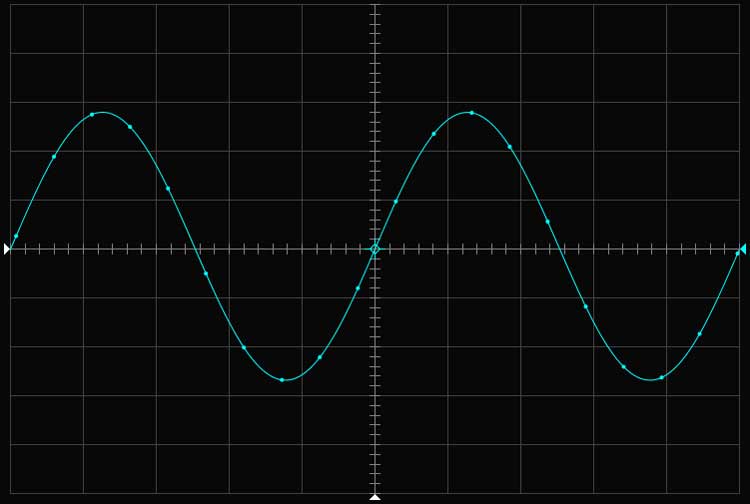
And at 20 kHz, beautiful.

The Sonus Faber Electa Amator III speakers just may be the perfect blend of sound quality, industrial design, and old-world craftsmanship that you can find today in the stand-mount category!
- Strong bass for such a small speaker
- One of the best tweeters you may ever hear
- The ability to take a lot of power
- Stunning design and craftsmanship
- Easy to use speaker wire terminals
- A permanent pair in my listening room!
Sonus faber has created a name for themselves over the years with their ability to create some of the best sounding speakers available and doing it with the typical Italian flair for design and craftsmanship. The Electa Amator III follows in this tradition, and in the process, really sets the bar in the world of stand-mount speakers. While I typically prefer the increased output capacity of large floor-standing speakers, these could easily pull me to the other side!
You are getting a piece of exquisite furniture here, along with an incredible sound. I have run out of adjectives to describe these speakers, so I looked up “superb” in the Merriam-Webster Dictionary and copied the synonyms: A-OK, A1, awesome, bang-up, banner, beautiful, blue-chip, blue-ribbon, boffo, bonny (also bonnie) [chiefly British], boss [slang], brag, brave, bully, bumper, capital, choice, classic, cool [slang], corking, crackerjack, cracking, dandy, divine, dope [slang], down [slang], dynamite, excellent, fab, fabulous, famous, fantabulous [slang], fantastic, fine, first-class, first-rate, first-string, five-star, four-star, frontline, gangbusters (also gangbuster), gilt-edged (or gilt-edge), gone [slang], grand, great, groovy, heavenly, high-class, hot, hype [slang], immense, jim-dandy, keen, lovely, marvelous (or marvellous), mean, neat, nifty, noble, number one (also No. 1), numero uno, out-of-sight [slang], par excellence, peachy, peachy keen, phat [slang], prime, primo [slang], prize, prizewinning, quality, radical [slang], righteous [slang], sensational, slick, splendid, stellar, sterling, superior, superlative, supernal, swell, terrific, tip-top, top, top-notch, top-of-the-line, top-shelf, topflight, topping [chiefly British], unsurpassed, wizard [chiefly British], wonderful.
My treasured company departs
Sonus faber’s sound is SUCH welcome medicine during this regimented isolation from family, friends, and the art world’s talents. I poured a glass of wine and whimpered on the couch after the speakers were picked up.
Secrets Sponsor
If your financial angels align, I highly recommend purchasing a pair of Electa Amator IIIs. They will help you stave off a long dark winter of COVID and crappy politics, and provide a lifetime of companionship and enjoyment.
I spent “A Day in a Life” with Wes Montgomery, had a taste of “Tennessee Whiskey” with Chris Stapleton, and Ed Sheeran was “Perfect”. I flew away with Norah Jones and got happy with Pharrell Williams. I ended my session by floating along with Ludwig Van Beethoven’s Moonlight Sonata and melting into total relaxation with Gustav Mahler’s Symphony #5 Adagietto. The sound is absolutely amazing. The highs are so clear they just float in the air. You can sense the vibration of the lows, but they do not overwhelm. The sound fills the room and is completely balanced. I found Sonus faber Electa Amator III’s voice and my heart.
Both John and Todd would like to thank Tracy Strom and Gary Young for their contributions to this review.


